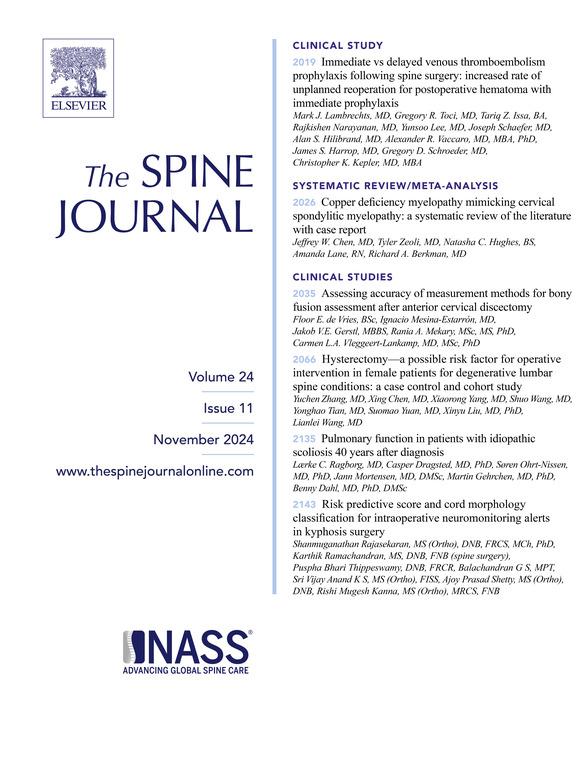8. 超越ODI:一项定性分析为什么患者在腰椎手术后满意,尽管未能达到MCID或PASS
IF 4.7
1区 医学
Q1 CLINICAL NEUROLOGY
引用次数: 0
摘要
腰椎手术后的临床结果通常使用Oswestry残疾指数(ODI)进行评估,定量指标包括最小临床重要差异(MCID)和患者可接受症状状态(PASS)。然而,这些指标未能反映“定性”患者满意度,特别是在描述改善但未达到MCID或PASS的患者子集中。目的:探讨微创腰椎手术后总体变化评分(GRC)改善但未达到ODI MCID或PASS阈值患者术后临床满意度的不同“主题”。研究设计/设置回顾性队列研究,在单一机构设置中对前瞻性收集的数据进行定性分析。患者SAMPLEA共评估了956例接受腰椎手术的患者,随访时间至少为6个月。其中,90例患者符合纳入标准(即GRC改善,未达到ODI MCID或PASS),其中43例患者同意参加半结构化访谈。患者报告的结果(PROMs)包括ODI,背部和腿部疼痛的视觉模拟量表(VAS), SF-12身体和精神成分(SF-12 PCS, SF-12 MCS)和PROMIS身体功能评分(PROMIS PF)。用GRC评价满意度。方法在随访早期(≤6个月)和后期(≥6个月)评价定量变化。使用卡方进行分类检验,使用独立t检验进行连续变量检验。Wilcoxon sign - rank检验比较早期和晚期配对GRC,配对t检验评估PROMs的变化。定性的半结构化访谈探讨了身体、情感和社会“主题”的满意度,并使用扎根理论进行了分析。使用维恩图来表示不同定性反应之间的重叠。结果GRC量表满意度在随访早期和晚期显著提高(p < 0.001)。VAS背部疼痛(79.1%)和腿部疼痛(74.4%)的MCID成活率较高。与早期时间点相比,1年时VAS背部评分有显著改善(-2.8±3.4,p = 0.011)。专题定性分析报告了满意度的主要影响因素:身体改善、生活质量、医疗保健提供者的互动和家庭支持。身体健康和生活质量之间的重叠突出了术后临床满意度的多维性。结论患者满意度超出了ODI等定量量表的范畴。整体评估,包括主观因素,如情绪健康、医疗保健提供者互动和家庭支持,是评估腰椎手术后恢复结果的先决条件和典型因素。FDA器械/药物状态本摘要不讨论或包括任何适用的器械或药物。本文章由计算机程序翻译,如有差异,请以英文原文为准。
8. Beyond the ODI: a qualitative analysis of why patients are satisfied after lumbar surgery despite failure to achieve MCID or PASS
BACKGROUND CONTEXT
Postoperative clinical outcomes after lumbar spine surgery are often evaluated using the Oswestry Disability Index (ODI), with quantitative metrics such as the minimal clinically important difference (MCID) and the patient’s acceptable symptom state (PASS). However, these metrics fail to reflect “qualitative” patient satisfaction, particularly among the subset of patients describing improvements but not achieving MCID or PASS.
PURPOSE
To identify different “themes” regarding postoperative clinical satisfaction following minimally invasive lumbar surgery in patients who improved on global rating of change (GRC) but did not achieve ODI MCID or PASS thresholds.
STUDY DESIGN/SETTING
Retrospective cohort study with a qualitative component for prospectively collected data at a single institution setting.
PATIENT SAMPLE
A total of 956 patients who underwent lumbar surgery with a minimum follow-up of 6 months were evaluated. Of these, 90 patients met the inclusion criteria (ie, improved on GRC and did not achieve ODI MCID or PASS), and 43 of these patients consented to participate in semi-structured interviews.
OUTCOME MEASURES
Patient-reported outcomes (PROMs) included ODI, visual analog scale (VAS) for back and leg pain, SF-12 physical and mental component (SF-12 PCS, SF-12 MCS), and PROMIS Physical Function scores (PROMIS PF). Satisfaction was assessed with GRC.
METHODS
Quantitative changes were evaluated at early (<6 months) and late (≥6 months) follow-ups. Chi-squared for categorical and independent t-tests for continuous variables were utilized. Wilcoxon Signed-Rank tests compared early and late paired GRC, while paired t-tests assessed changes in PROMs. Qualitative semi-structured interviews exploring satisfaction across physical, emotional, and social “themes,” were analyzed using grounded theory. Venn diagrams were utilized to signify the overlap between different qualitative responses.
RESULTS
Satisfaction on the GRC scale significantly improved between early and late follow-ups (p < 0.001). High MCID achievement rates for VAS back (79.1%) and leg pain (74.4%) were observed. There was a significant improvement in the VAS back score at 1 year (-2.8 ± 3.4, p = 0.011) compared to the earlier time point. Thematic qualitative analysis reported key contributors to satisfaction: physical improvement, quality of life, healthcare provider interactions, and family support. Overlaps, such as between physical health and quality of life, highlighted the multidimensional nature of postoperative clinical satisfaction.
CONCLUSIONS
Patient satisfaction extends beyond quantitative scales like the ODI. Holistic assessment, including subjective factors such as emotional well-being, healthcare provider interactions, and family support, are prerequisite and quintessential factors for evaluating recovery outcomes after lumbar surgery.
FDA Device/Drug Status
This abstract does not discuss or include any applicable devices or drugs.
求助全文
通过发布文献求助,成功后即可免费获取论文全文。
去求助
来源期刊

Spine Journal
医学-临床神经学
CiteScore
8.20
自引率
6.70%
发文量
680
审稿时长
13.1 weeks
期刊介绍:
The Spine Journal, the official journal of the North American Spine Society, is an international and multidisciplinary journal that publishes original, peer-reviewed articles on research and treatment related to the spine and spine care, including basic science and clinical investigations. It is a condition of publication that manuscripts submitted to The Spine Journal have not been published, and will not be simultaneously submitted or published elsewhere. The Spine Journal also publishes major reviews of specific topics by acknowledged authorities, technical notes, teaching editorials, and other special features, Letters to the Editor-in-Chief are encouraged.
 求助内容:
求助内容: 应助结果提醒方式:
应助结果提醒方式:


